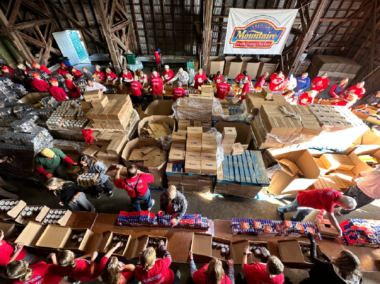Preparing the Supply Chain for Future Pandemics

Manufacturers can take specific steps to improve the resilience of the health care supply chain, the NAM’s latest health care study found.
What’s going on: The study—conducted by the Manufacturing Policy Initiative at Indiana University—analyzes data from the COVID-19 pandemic, when manufacturers in the U.S. had to produce large quantities of critical health care equipment under difficult, fast-evolving conditions.
Building resilience: The study found that to prepare the supply chain for a future disruption of similar magnitude, manufacturers should focus on seven areas:
- Speed: Manufacturers must be able to satisfy demand quickly.
- Information: Manufacturers require timely access to accurate information.
- Cost: Firms face the costs of taking action within the supply chain, as well as the costs of managing market unpredictability and policy environment uncertainty.
- Networks: Partnerships can support information sharing and networks to help manufacturers navigate the disruption.
- Size: Supply chain challenges can look different for small, medium-sized and new manufacturers than for larger, established firms.
- Technology: Tech can help manufacturers increase production, improve efficiency and speed up innovation.
- Flexibility: Responses can come from unexpected sources and need a flexible policy environment.
The NAM says: “Policymakers should utilize these lessons to bolster our supply chain for the next disruption,” NAM Chief Economist Chad Moutray said. “This analysis … reveals that there are key policy actions needed to strengthen the manufacturing supply chain. Research shows a more balanced regulatory agenda, with an emphasis on clarity, predictability and coordination, will help mitigate the effects of the next disruption.”
New Study: U.S. Health Care Supply Chain Resilience Demands Balanced Regulatory Environment
Washington, D.C. – The National Association of Manufacturers released a new study outlining steps to improve health care supply chain resilience to allow manufacturers in the United States to better prepare for and adapt to the next disruption. The study analyzes lessons learned from the COVID-19 pandemic, during which manufacturers across the United States produced critical health care supplies in a highly unpredictable environment that affected every industry level.
“During the COVID-19 pandemic, manufacturers in the United States helped lead our response and recovery and learned many lessons in the process,” said NAM Chief Economist Chad Moutray. “Policymakers should utilize these lessons to bolster our supply chain for the next disruption. This analysis, which was conducted by the Manufacturing Policy Initiative at Indiana University, reveals that there are key policy actions needed to strengthen the manufacturing supply chain. Research shows a more balanced regulatory agenda, with an emphasis on clarity, predictability and coordination, will help mitigate the effects of the next disruption.”
Key Themes
Seven key lessons from the pandemic can be examined for future efforts to build resilience:
- Speed matters: Manufacturers need to be able to serve demand quickly.
- Information matters: Manufacturers need timely access to accurate information.
- Costs matter: Firms face the costs of taking action within the supply chain, as well as the costs of managing market unpredictability and policy environment uncertainty.
- Networks matter: Partnerships can support information sharing and networks to help manufacturers navigate the disruption.
- Size matters: Small and medium-sized manufacturers and new firms can be differently—and uniquely—challenged compared with established larger manufacturers.
- Technology matters: Technology can enable manufacturers to enhance production, innovate or improve efficiency, as well as support broader efforts to build partnerships.
- Flexibility matters: Responses can come from unexpected sources and need a flexible policy environment.
Areas of Opportunity
The report identifies four key areas of opportunity to enhance health care supply chain resilience:
- Fostering a conducive regulatory environment: Manufacturers and their partners need clear and streamlined regulations as well as a flexible regulatory framework in advance of the next disruption.
- Supporting partnerships for stronger information sharing and networks: Sustained information channels between manufacturers and policymakers will improve access to information for all parties and mitigate disruptions.
- Ensuring a healthier “baseline” industry: Small business plays a pivotal role in the U.S. Robust entrepreneurship and scaling of new manufacturers contribute to a more competitive industry.
- Prioritizing changing workforce needs: Workforce development must be prioritized so that manufacturers can pivot across product lines and sectors to meet the needs of the next disruption.
-NAM-
The National Association of Manufacturers is the largest manufacturing association in the United States, representing small and large manufacturers in every industrial sector and in all 50 states. Manufacturing employs nearly 13 million men and women, contributes $2.91 trillion to the U.S. economy annually and accounts for 55% of private-sector research and development. The NAM is the powerful voice of the manufacturing community and the leading advocate for a policy agenda that helps manufacturers compete in the global economy and create jobs across the United States. For more information about the NAM or to follow us on Twitter and Facebook, please visit www.nam.org.
How Novocure’s Anti-Cancer Device Extends Lives

Around 15,000 people are diagnosed every year in America with glioblastoma, a particularly aggressive form of brain cancer. At Novocure—a global oncology and medical device company with its North American flagship facility located in Portsmouth, New Hampshire—scientists and manufacturers have developed a device to revolutionize the way these tumors are treated.
The breakthrough: Novocure’s founder Yoram Palti developed an innovative treatment called Tumor Treating Fields therapy—an approach that uses electric fields to kill cancer cells while sparing healthy ones.
- For adult glioblastoma patients, the device, called Optune®, consists of wearable, portable adhesive arrays and an electric generator that can be carried in a bag.
- “Unhealthy cells and healthy cells have different properties,” said Frank Leonard, president, CNS Cancers U.S. at Novocure. “If you can create the right type of electric field, you can exert force and destroy cancer cells as they divide.”
Value added: Crucially, Tumor Treating Fields therapy is being studied together with other therapies, giving patients access to an optimal mix of treatments.
- “You get the best of both worlds with a device intervention and a drug intervention,” said Leonard. “Patients can wear this device consistently while using Temozolomide, which is the current standard of care chemotherapy agent used to treat glioblastoma.”
Low risk: Unlike drug therapies, which can present a range of adverse effects, Optune® has few side effects beyond mild-to-moderate skin irritation beneath the transducer arrays. As a result, patients can receive the treatment continuously for extended periods of time to attack cancer cells.
- “Typically, the limiting factor in treating cancer is dose-limiting toxicity—for example, you can only take one or two chemotherapies at the same time because they’re so toxic,” said Leonard.
Getting heard: The company’s device was featured in the award-winning short film “Rare Enough,” which tells the inspiring story of cancer survivor DJ Stewart and his journey in battling glioblastoma.
- Stewart is a Kansas City–based skateboarder who was first diagnosed with glioblastoma in 2019. Thanks, in part, to Tumor Treating Fields therapy, his life expectancy—once only 13 months—has been prolonged significantly. DJ now serves as a community outreach coordinator for the Head for the Cure Foundation.
Next steps: Novocure believes that Tumor Treating Fields therapy holds significant promise for other types of cancer as well. The company is developing additional wearable devices that could treat countless patients around the world.
- Lung cancer trials have shown promising results recently, and the company expects to learn more in the coming months from clinical trials involving ovarian cancer, metastases from lung cancer and pancreatic cancer.
- “We started working first in one of the rarer, yet most aggressive, forms of cancer. There are around 15,000 patients diagnosed with glioblastoma in the U.S. each year,” said Leonard. “But pre-clinical data suggests that Tumor Treating Fields can work with all different tumor types.”
A look to the future: Wearable anti-cancer devices offer an exciting new frontier in the fight against life-threatening diseases, and an important field where manufacturers can make an enormous difference.
- “In these really aggressive cancers, we still are making advances—and advanced devices that require sophisticated engineering and complex global manufacturing have a role to play,” said Leonard. “There’s a lot the manufacturing industry can do to improve the outcomes of patients, and they should be recognized for that work.”
New COVID-19 Vaccines Coming

A new COVID-19 vaccine is set for a September release as cases of the new virus variant “Eris” rise nationwide, according to Reuters (subscription).
What’s going on: “Some public health experts hope that Americans will welcome the new shot as they would a flu jab. But demand for the vaccine has dropped sharply since 2021 when it first became available and more than 240 million people in the U.S., or 73% of the population, received at least one shot.”
- Health care providers and pharmacies will begin offering the updated shots—which target XBB.1.5, “a sub-lineage of the still dominant Omicron variant”—in the second half of next month.
- The new vaccines still need authorization by the U.S. Food and Drug Administration and recommendation by the Centers for Disease Control and Prevention.
Why it’s important: Though the COVID-19 public health emergency ended in May and the private sector has taken on “much of the duty of vaccinating America,” virus-related hospitalizations are up 40% from June’s lows.
- “CDC Director Mandy Cohen said last week in a podcast that … Americans should view these shots as an annual measure to protect oneself, in line with the annual flu shot.”
Consumer Debt Grew in June

Consumer credit rose more than anticipated in June, according to USA Today.
What’s going on: “Overall credit increased $17.8 billion, topping economists’ average forecast for a $13 billion gain, to $4.977 trillion in June, the Fed said late Monday. May’s borrowing also was revised up by about $2 billion.”
- However … despite the June rise, “overall credit increases have moderated over the past year, showing the Fed’s aggressive interest rate hikes to squelch spending and lower inflation are working.”
“Nonrevolving” credit: Nonrevolving credit—lump sums repaid only once, such as those for school tuition and car purchases—jumped by $18.5 billion to $3.735 trillion, largely on the strength of auto sales.
Short-term debt: Short-term debt, such as credit card debt, fell in June for the first time in more than two years, to $1.262 trillion. This is likely due to the sharp increase in credit card interest rates, according to a report cited by USA Today.
The big picture: Consumer spending has stayed steady despite rising inflation owing to savings built up during the global pandemic.
Internet Providers Ramp Up Subsidized Broadband Plans

New plans from internet providers are part of the Biden administration’s effort to increase access to broadband and reach more users, according to The Wall Street Journal (subscription).
What’s happening: “Twenty internet providers, including AT&T Inc. [and] Comcast Corp. … agreed to improve subsidized high-speed internet plans they offer to millions of unconnected households.”
- The move is part of the Affordable Connectivity Program that was launched as part of last year’s bipartisan infrastructure plan.
- The infrastructure plan allocated $14 billion to the program as part of the effort to bolster America’s broadband network.
The goal: The Affordable Connectivity Program has failed to reach most of its eligible subscribers because people most in need have no access to the internet and aren’t aware that they’re eligible for a major discount. An important part of the new plans is ensuring that they’re accessible to the most users.
- “Many of the companies, which cover more than 80% of the U.S. population, agreed Monday to either boost the internet speeds that they offer through the program or to cut their rates to $30 a month for low-income and other households that qualify.”
Who’s eligible: An estimated 48 million households are eligible for the subsidy. According to the Federal Communications Commission, about 11.5 million households have already signed up for the subsidy.
- The Biden administration has launched a new website, GetInternet.gov, to provide information to Americans about signing up for the subsidies.
The NAM’s view: The NAM has been a strong supporter of expanded access to broadband for years, citing its importance in the policy blueprint “Building to Win.”
NAM Study: Employer-Provided Health Plan Costs Are Rising

Providing health care benefits to workers is becoming increasingly expensive for manufacturers, but Congress can take measures to help offset these costs, according to a new NAM study.
What’s going on: The NAM released “Manufacturers on the Front Lines of Communities: A Deep Commitment to Health Care” yesterday. The report includes the results of surveys and manufacturer interviews that detail industry-wide health benefits and trends, as well as federal policy proposals that could jeopardize manufacturers’ ability to continue offering health care plans.
Key findings: Below are some of the report’s most notable takeaways:
- Tax incentives: Designing and offering health care benefits is getting more expensive for employers. To fight these rising costs, Congress must keep in place the tax benefits offered to companies providing such plans to workers.
- Affordability: Employer-offered health care must be affordable for employees. To ensure that it is, Congress should consider seeking revision of some of the opaque rules governing health and flexible savings accounts and pharmacy benefit managers.
- Early intervention: Intervening in health-related situations early—as in the cases of obesity, cancer and other conditions—can lower future costs for employers and employees alike. Primary care can catch and help correct many illnesses and so must be incentivized.
The last word: “Manufacturers feel a deep commitment to providing quality health care for their employees despite the increased costs and challenges of doing so,” said NAM Director of Human Resources and Innovation Policy Julia Bogue.
- “Manufacturers are innovative in their health benefits to best address the challenges employees face, from primary care to chronic-condition management.”
NAM Hits Back at Price Controls in PAHPA Draft

The Pandemic and All-Hazards Preparedness Act, which expires at the end of September, is critical to public-health emergency readiness. Yet, a Senate bipartisan discussion draft to reauthorize it contains some provisions that are troubling to manufacturers, the NAM told the Senate Committee on Health, Education, Labor & Pensions this week.
The background: The Senate released a draft of a bill last week to reauthorize PAHPA, a measure passed in 2006 with the intention of ensuring national readiness for public-health emergencies.
Imposing price caps: The draft contains a requirement to cap the cost of any product that has received support from either the Centers for Disease Control and Prevention or the Biomedical Advanced Research and Development Authority “at the lowest price charged for such … product[s]” among the G7 countries (the U.S., Canada, France, Germany, Italy, Japan and the United Kingdom).
- Such a move would erase the advances made over the decades since the 1980 passage of the Bayh-Dole Act, which created mutually beneficial economic partnerships between the federal government, universities and private industry, NAM Managing Vice President of Policy Chris Netram said in his message to the committee.
- A price limit “would reduce the positive impact of the Bayh-Dole Act by imposing price controls on products developed through the innovation spurred by these partnerships,” he said.
Deterring innovation: Pricing controls also threaten continued scientific advancements of the sort that have cured once-prevalent diseases and solved “some of the world’s most prevalent and challenging health issues,” Netram continued.
- “The development of new medicines demands tremendous financial investment, many years of intensive effort and a willingness to accept significant risk. While public–private partnerships are important in stewarding new drugs to market, pharmaceutical companies bear almost the entire cost of discovering new drugs, ushering them to approval and scaling them through manufacturing.”
- In 2019, the pharmaceuticals industry invested more than $83 billion in the research and development of new drugs, Netram said, citing Congressional Budget Office data.
Stopping the flow of medication: Perhaps most concerningly, setting cost caps on drugs also jeopardizes the flow of medications to those who need them, Netram told the committee.
- “Price controls … restrict the supply of medicines to patients,” Netram concluded. “As such, price control language should be excluded from the PAHPA.”
States to Get Funds to Expand Internet Access

More than $42 billion will be given to states to expand their broadband internet access, the White House announced this week, according to The Wall Street Journal (subscription).
What’s going on: “States and territories have been jockeying for months for their share of $42.5 billion allocated in an internet-construction fund called the Broadband Equity Access and Deployment program. The law requires that federal agencies use a new, more accurate map of where high-speed internet service is missing before disbursing the funds.”
- Texas will get the most money under the project ($3.3 billion) followed by California ($1.9 billion). Also set to receive significant sums are the less-populous Alaska, West Virginia and Montana.
The goal: The effort is meant to connect everyone in the U.S. to “affordable, high-speed internet service by 2030,” according to the Journal.
Why it’s important: Approximately 8.5 million U.S. households and businesses are located in areas of the country without access to high-speed internet access, which the Biden administration called “a necessity in today’s society” in an announcement about the funds.
- BEAD is one of six federal internet-construction programs authorized by the NAM-backed bipartisan infrastructure law of 2021.
- The legislation also includes $2.75 billion for digital equity and inclusion and $2 billion in loans and grants for internet infrastructure in rural locations, CNET reports.
Our view: “Manufacturers supported the bipartisan infrastructure law, and today’s historic broadband investment announcement will enhance industry operations through leading edge connectivity,” the NAM tweeted on Monday. “Thank you @POTUS for your leadership to advance domestic [manufacturing] priorities.”
“Mountaire Cares” Is More Than Just a Slogan
“Making a difference” might be the best description of what Mountaire Farms does. Founded in 1914, the fifth-generation family-owned chicken processing company has a long history of helping its communities thrive.
Mountaire Cares: Through its Mountaire Cares program, the company’s employees are committed to changing lives for the better.
- “The Mountaire Cares program was created to fulfill three main core pillars: how are we faithful to our people, how are we faithful to our communities and how can we look to be faithful to the future,” said Mountaire Cares Director JR LaPearl.
Meals for thousands: One of Mountaire Farms’ biggest events during the year is its Meals for Thousands program, where the company partners with local churches, food banks and nonprofit organizations to provide meals for families in need at Easter, Thanksgiving and Christmas.
- The program had humble beginnings 28 years ago, with Roger Marino, who was PR and community relations director at Mountaire, leading the group to provide 300 meal boxes at Thanksgiving. The company has distributed more than 1 million boxes since then.
- For this year’s Easter event, the company’s employees and other volunteers packed 15,000 meal boxes, each of which contained a Mountaire roaster chicken; vegetables; macaroni and cheese; mashed potatoes and gravy; and brownies—enough food to feed a family of four.
- “Our employees really enjoy being a part of this effort to give back to the community,” LaPearl said. “What I love about these events is that they bring people together to share love and kindness to one another.”
Feeding all year long: But hunger doesn’t just exist during holidays. Mountaire Farms donates chicken to local food pantries every month so they can help fill the need all year long. And they partner with groups like nonprofit organizations, little leagues, fire companies and more that use chicken to help fundraise during the year.
And that’s not all . . . Mountaire’s food programs are just one way the company gives back. It has partnered with Habitat for Humanity and several Boys & Girls Clubs on service projects, while also collaborating with local schools on renovations of playgrounds and basketball courts.
Why they do it: For LaPearl, it all starts with the company’s mantra “High Performance for a Higher Purpose,” striving to be a positive light to those around them.
- “Our people are the reason we’re able to do what we do and give back,” said LaPearl. “If it’s not volunteering, it’s the everyday work that we do that really helps to feed families here locally, around the region and around the world. It’s interesting when our employees are upset they were unable to volunteer on a particular day. I remind them that what you’re doing on a daily basis is making a major impact in the lives of people that you don’t even know because of your hard work and performance.”
- “When I have the opportunity to visit our processing plants and I see people smiling, singing in their respective cultural languages and just enjoying their job, that speaks volumes in today’s culture. I can tell they love being here. That’s the way we’re built.”
Mountaire cares about its employees: Through Mountaire Cares, the company offers leadership classes to help employees succeed in their roles and advance in their careers. It also provides scholarships to children and grandchildren of employees.
- In addition, the company built medical facilities at each of its processing plants, and recently established a chaplaincy program that offers employees guidance in times of crisis and high stress.
The last word: LaPearl has some advice for manufacturers who may want to start a program similar to Mountaire’s:
- “Clearly understand your strengths as a company and create an exceptional foundation to build off that. We weren’t able to do all of this overnight, so start small and really focus the first few years on going slow and being purposeful. And always show your employees you care.”
